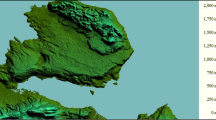Abstract
Aviation is a basic necessity of our world, but its contribution to air pollution is considered significant. In this paper, the contribution of air traffic to air pollution levels in the area of the three larger airports of Greece is examined through the use of EDMS (Emission and Dispersion Modeling System), a regulatory model proposed by the US EPA (United States Environmental Protection Agency). To ensure a better understanding of air traffic contribution to air quality levels, the hourly aircraft movements along with the corresponding meteorological data for a whole year, 2009, were taken into account. During this year, air traffic peaked both in Greece as a total and in each of the three airports of this work. Airport emissions calculated by EDMS are found to be in good agreement with emissions monitored at Athens International Airport as well as with emission results and published data for International Zurich Airport. Concentration results have shown that PM10 and SO2 concentrations are well below the limit values, whereas NO2 concentrations exceeding limit value are expected in small areas under specific circumstances, when heavy air traffic coincides with meteorological conditions favoring air pollutant accumulation. Finally, the comparison of computational results with monitoring air quality data shows a good agreement, if other sources of air pollution are excluded.










Similar content being viewed by others
References
World Health Organization (2016) Ambient (outdoor) air quality and health factsheet. In: WHO. https://goo.gl/iJomX. Accessed 18 Dec 2016.
Vallero, D. (2014). Chapter 14 - air pollution’s impact on ecosystems. In Fundamentals of air pollution (5th ed., pp. 341–368). Boston: Academic Press.
NASA (2015) Aura Shows Human Fingerprint on Global Air Quality. https://goo.gl/zbq9QF. Accessed 20 Dec 2016.
European Environment Agency. (2016). Air quality in Europe - 2016 report. Denmark: Copenhagen.
Hellenic Ministry of Environment and Energy (2015) Update of the mapping of atmospheric pollution based on recording emissions of sources and developing a suitable computational tool. Athens.
Hellenic Ministry of Environment and Energy (2016) Annual report of air pollution 2015. Athens.
Athens International Airport S.A. (2016) Care for the environment 18. http://bit.ly/2svzKmf. Accessed 25 Jun 2017.
Barrett, S. R. H., Britter, R. E., & Waitz, I. A. (2010). Global mortality attributable to aircraft cruise emissions. Environmental Science & Technology, 44, 7736–7742. https://doi.org/10.1021/es101325r.
ICAO (2011) Airport air quality manual.
National Academies of Sciences E (2015) Understanding Airport Air Quality and Public Health Studies Related to Airports.
Targino, A. C., Machado, B. L. F., & Krecl, P. (2017). Concentrations and personal exposure to black carbon particles at airports and on commercial flights. Transportation Research Part D: Transport and Environment, 52, 128–138. https://doi.org/10.1016/j.trd.2017.03.003.
Proyou, A. G., Moussiopoulos, N., & Karatzas, K. (1995). Air quality impact caused by the transfer of the Athens airport from Hellenikon to Spata. In H. Power, N. Moussiopoulos, & C. A. Brebbia (Eds.), Air pollution III (pp. 131–139). Southampton: Computational Mechanics Publications.
Penn, S. L., Arunachalam, S., Tripodis, Y., Heiger-Bernays, W., & Levy, J. I. (2015). A comparison between monitoring and dispersion modeling approaches to assess the impact of aviation on concentrations of black carbon and nitrogen oxides at Los Angeles International Airport. Science of the Total Environment, 527–528, 47–55. https://doi.org/10.1016/j.scitotenv.2015.03.147.
Simonetti, I., Maltagliati, S., & Manfrida, G. (2015). Air quality impact of a middle size airport within an urban context through EDMS simulation. Transportation Research Part D: Transport and Environment, 40, 144–154. https://doi.org/10.1016/j.trd.2015.07.008.
Unal, A., Hu, Y., Chang, M. E., et al. (2005). Airport related emissions and impacts on air quality: application to the Atlanta International Airport. Atmospheric Environment, 39, 5787–5798. https://doi.org/10.1016/j.atmosenv.2005.05.051.
Airparif (2017) Air quality monitoring network in Île-de-France. https://www.airparif.asso.fr. Accessed 26 Feb 2017.
Environmental Research Group at King’s College London (2016) London Air Quality Network. http://www.londonair.org.uk. Accessed 26 Feb 2017.
Senate Department of Urban Development and Environment (2017) Berlin Air Quality Monitoring Network. http://bit.ly/2lT8UCe. Accessed 26 Feb 2017.
Airparif (2016) Survol. http://survol.airparif.fr/. .
Berlin Brandenburg Airport (2017) Air quality monitoring. In: Berlin Brandenburg Airport. http://bit.ly/2lTenZE. Accessed 26 Feb 2017.
Fraport AG (2017) Air Quality. http://bit.ly/2lTacga. Accessed 26 Feb 2017.
Heathrow Airwatch (2017) Monitoring data. http://bit.ly/2lT8Br2. Accessed 26 Feb 2017.
Munich Airport (2017) Air quality. http://bit.ly/2lTa5S7. Accessed 26 Feb 2017.
Federal Aviation Administration (2013) EDMS 5.1.4 User Manual.
Federal Aviation Administration (2015) AEDT: Product Information. http://bit.ly/2NAR7yq. Accessed 23 Sep 2018.
NOAA/ESRL (2010) Radiosonde Database. http://bit.ly/2ReYtbY. Accessed 10 Jan 2011.
EUROCONTROL (2015) Base of aircraft data factsheet.
Kwan I (2014) Back to the Future: Return of the Turboprop? | International Council on Clean Transportation. https://www.theicct.org/node/766. Accessed 17 Sep 2018.
Lozano, E. R., Walter Jr., W. M., & Ochheiser, S. (1968). Air pollution emissions from jet engines. Journal of the Air Pollution Control Association, 18, 392–394. https://doi.org/10.1080/00022470.1968.10469144.
Athens International Airport S.A (2009) Care for the Environment 11. http://bit.ly/2JmFOat. Accessed 30 Oct 2011.
Kurniawan, J. S., & Khardi, S. (2011). Comparison of methodologies estimating emissions of aircraft pollutants, environmental impact assessment around airports. Environmental Impact Assessment Review, 31, 240–252. https://doi.org/10.1016/j.eiar.2010.09.001.
Duchene N, Celikel A, Fleuti E, et al. (2004) Emission inventory for Zurich airport with different methodologies. EUROCONTROL.
Fleuti E, Hofmann P, Talerico C (2006) Airport local air quality, Sensitivity Analysis Zurich Airport.
Owen RC, Brode R (2014) Clarification on the use of AERMOD dispersion modeling for demonstrating compliance with the NΟ2 National Ambient Air Quality Standard.
US-EPA (2015) Technical support document for NO2-related AERMOD modifications.
Theophanides, M., & Anastassopoulou, J. (2009). Air pollution simulation and geographical information systems (GIS) applied to Athens International Airport. Journal of Environmental Science and Health, Part A, 44, 758–766. https://doi.org/10.1080/10934520902928354.
Perry, S. G., Cimorelli, A. J., Paine, R. J., et al. (2005). AERMOD: a dispersion model for industrial source applications. Part II: model performance against 17 field study databases. Journal of Applied Meteorology, 44, 694–708. https://doi.org/10.1175/JAM2228.1.
Rood, A. S. (2014). Performance evaluation of AERMOD, CALPUFF, and legacy air dispersion models using the Winter Validation Tracer Study dataset. Atmospheric Environment, 89, 707–720. https://doi.org/10.1016/j.atmosenv.2014.02.054.
Zou, B., Benjamin Zhan, F., Gaines Wilson, J., & Zeng, Y. (2010). Performance of AERMOD at different time scales. Simulation Modelling Practice and Theory, 18, 612–623. https://doi.org/10.1016/j.simpat.2010.01.005.
O’Connor, C. M., Anamaterou, E. P., & Leivaditis, E. G. (2004). Air quality in the Mesogaia plain in eastern Attica before and after the opening of the Athens International Airport. WIT Transactions on Ecology and the Environment, 74, 10. https://doi.org/10.2495/AIR040291.
Pateraki, S., Assimakopoulos, V. D., Maggos, T., Fameli, K. M., Kotroni, V., & Vasilakos Ch. (2013). Particulate matter pollution over a Mediterranean urban area. Science of the Total Environment, 463–464, 508–524. https://doi.org/10.1016/j.scitotenv.2013.05.076.
Progiou, A. G., & Ziomas, I. C. (2015). Predicting annual average particulate concentration in urban areas. Science of the Total Environment, 532, 353–359. https://doi.org/10.1016/j.scitotenv.2015.05.095.
Arunachalam, S., Valencia, A., Silva, R. A., et al. (2016). A global-scale multi-resolution study of surface air quality impacts from commercial aircraft emissions. In Air pollution modeling and its application XXV (pp. 529–534). Cham: Springer.
Ashok, A., Dedoussi, I. C., Yim, S. H. L., et al. (2014). Quantifying the air quality-CO2 tradeoff potential for airports. Atmospheric Environment, 99, 546–555. https://doi.org/10.1016/j.atmosenv.2014.10.024.
Dorbian, C. S., Wolfe, P. J., & Waitz, I. A. (2011). Estimating the climate and air quality benefits of aviation fuel and emissions reductions. Atmospheric Environment, 45, 2750–2759. https://doi.org/10.1016/j.atmosenv.2011.02.025.
Lee, D. S., Fahey, D. W., Forster, P. M., et al. (2009). Aviation and global climate change in the 21st century. Atmospheric Environment, 43, 3520–3537. https://doi.org/10.1016/j.atmosenv.2009.04.024.
Author information
Authors and Affiliations
Corresponding author
Additional information
Publisher’s Note
Springer Nature remains neutral with regard to jurisdictional claims in published maps and institutional affiliations.
Highlights
• EDMS was applied to estimate air pollution levels in the area of 3 large airports.
• Emissions, especially for NOx, are in good agreement with previous results.
•A NOx emission rate of 4 to 5 kg per aircraft movement has been calculated.
• CO, PM10, and SO2 concentrations were found well under limit values.
• Higher concentrations of NO2 were found, but only under specific circumstances.
• In the nearby residential areas, local sources dominate in air pollution levels.
• Model results are generally in good agreement with monitoring data, if effects from other sources are excluded.
Rights and permissions
About this article
Cite this article
Koulidis, A.G., Progiou, A.G. & Ziomas, I.C. Air Quality Levels in the Vicinity of Three Major Greek Airports. Environ Model Assess 25, 749–760 (2020). https://doi.org/10.1007/s10666-020-09699-6
Received:
Accepted:
Published:
Issue Date:
DOI: https://doi.org/10.1007/s10666-020-09699-6




